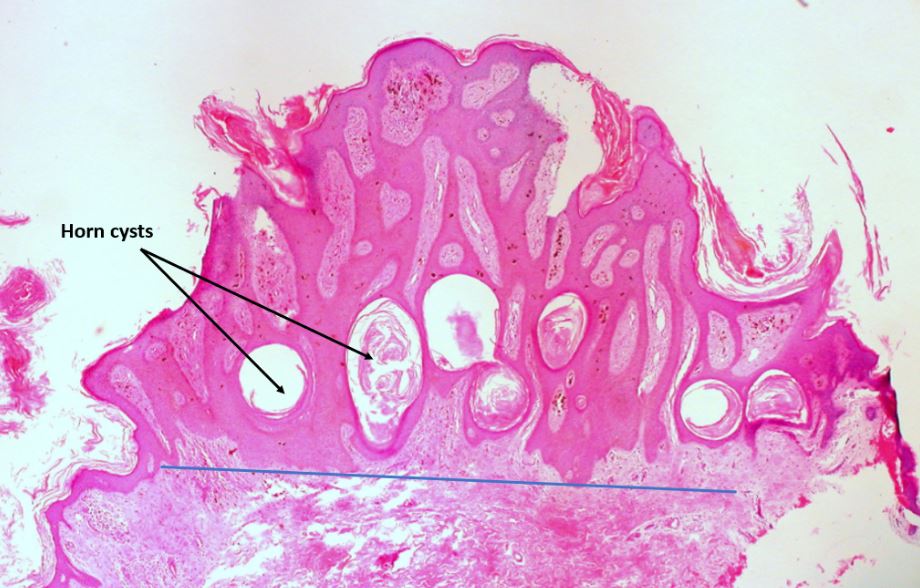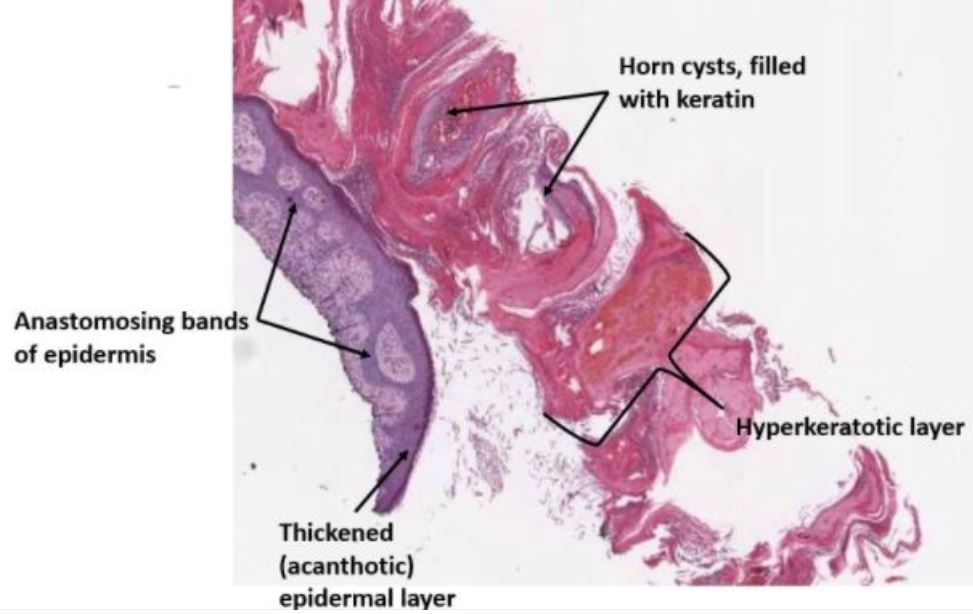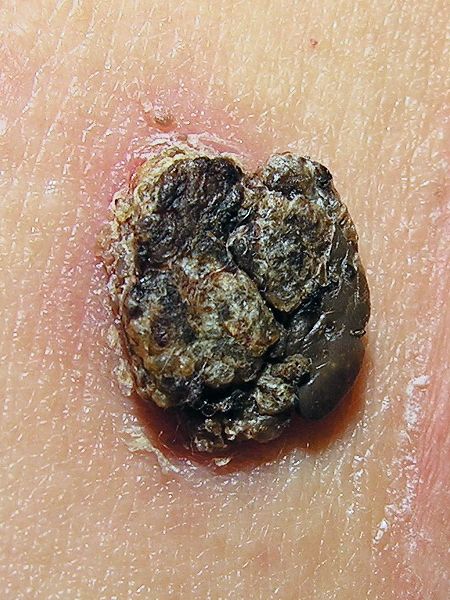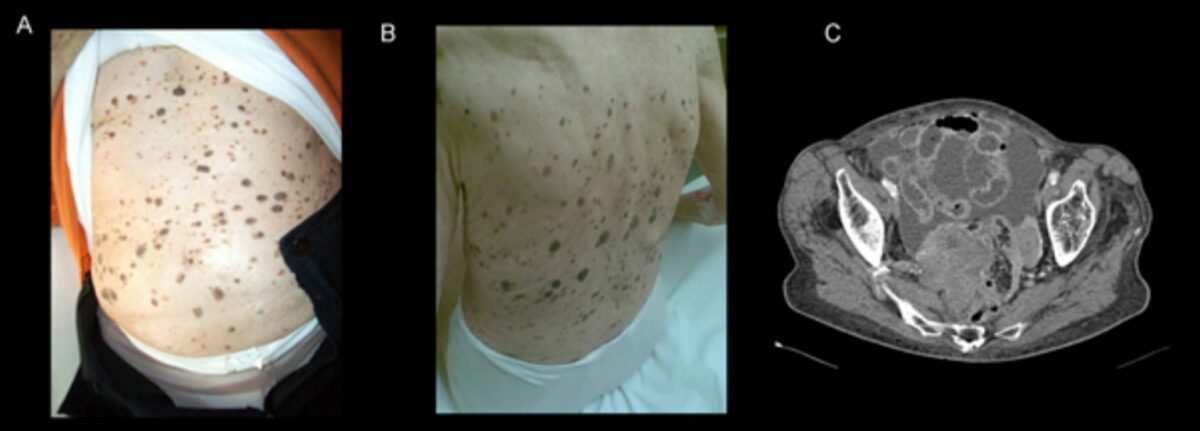Seborrheic keratosis (SK) is the most common benign epithelial cutaneous neoplasm. It is a pigmented, predominantly basal (immature) keratinocytic proliferation that occurs mostly on the trunk of middle-aged and elderly adults, and may be single or multiple. It presents as a sharply demarcated, exophytic skin lesion that may be tan or black and has a “stuck-on” appearance. Pruritus or pain can occur if these lesions become secondarily inflamed by trauma, especially if they are within the skin folds. Genetics are thought to play a role, but the pathogenesis is uncertain. The most common mutations involve two oncogenes: fibroblast growth factor receptor 3 (FGFR3) and PIK3CA. There is a familial predisposition to develop a high number of seborrheic keratoses. The sudden appearance of, or increase in the number and size of, seborrheic keratoses in association with internal malignant disease is known as the Leser–Trélat sign. Treatment is not necessary, as this is a benign condition, but cryotherapy, curettage, or electrodesiccation can be performed for discomfort or cosmetic concerns.
Last updated: Dec 15, 2025
Seborrheic keratosis Seborrheic keratosis Seborrheic keratosis (SK) is the most common benign epithelial cutaneous neoplasm. The condition consists of immature keratinocytes. Seborrheic keratosis is the most common benign skin tumor in middle-aged and elderly adults and presents as a sharply demarcated, exophytic, skin lesion that may be tan or black and has a “stuck-on” appearance. Seborrheic Keratosis ( SK SK Seborrheic keratosis (sk) is the most common benign epithelial cutaneous neoplasm. The condition consists of immature keratinocytes. Seborrheic keratosis is the most common benign skin tumor in middle-aged and elderly adults and presents as a sharply demarcated, exophytic, skin lesion that may be tan or black and has a “stuck-on” appearance. Seborrheic Keratosis) is a benign Benign Fibroadenoma skin Skin The skin, also referred to as the integumentary system, is the largest organ of the body. The skin is primarily composed of the epidermis (outer layer) and dermis (deep layer). The epidermis is primarily composed of keratinocytes that undergo rapid turnover, while the dermis contains dense layers of connective tissue. Skin: Structure and Functions tumor Tumor Inflammation consisting of proliferating immature keratinocytes Keratinocytes Epidermal cells which synthesize keratin and undergo characteristic changes as they move upward from the basal layers of the epidermis to the cornified (horny) layer of the skin. Successive stages of differentiation of the keratinocytes forming the epidermal layers are basal cell, spinous or prickle cell, and the granular cell. Skin: Structure and Functions.

Pigmented seborrheic keratosis of the vulva:
Note the domed shape, sharp circumscription from the surrounding skin, horn cysts, and the brown melanin pigment within the epidermis and in the adjacent dermis (within macrophages).
The blue line below the lesion demonstrates the “string sign” of SK seen at low-power magnification: A horizontal line can be drawn parallel to the epidermal surface underlying the lesion because the SK extends uniformly to one depth.

Low-power microphotograph of a shave biopsy of a hyperkeratotic seborrheic keratosis showing the superficial pink-staining keratinous material partially detached from the surface.
Note the thickened epidermis with anastomosing strands of proliferating basaloid cells within the epidermis.

Seborrheic keratosis with rough surface:
Note the typical waxy appearance, the well-circumscribed border, and the superficial stuck-on appearance.

A and B: Leser–Trélat sign in a 92-year-old woman with advanced ovarian cancer. Multiple eruptive seborrheic keratoses had dramatically increased in size and number over the previous 2 years.
C: CT scan showing a necrotic ovarian tumor accompanied by signs of peritoneal carcinomatosis
Although SK SK Seborrheic keratosis (sk) is the most common benign epithelial cutaneous neoplasm. The condition consists of immature keratinocytes. Seborrheic keratosis is the most common benign skin tumor in middle-aged and elderly adults and presents as a sharply demarcated, exophytic, skin lesion that may be tan or black and has a “stuck-on” appearance. Seborrheic Keratosis is most often diagnosed and managed by dermatologists, it is important for all physicians Physicians Individuals licensed to practice medicine. Clinician–Patient Relationship to be aware of the diagnostic and management options available.[8]
Physical exam:
Dermoscopy Dermoscopy A noninvasive technique that enables direct microscopic examination of the surface and architecture of the skin. Seborrheic Keratosis:
Biopsy Biopsy Removal and pathologic examination of specimens from the living body. Ewing Sarcoma:
Diagnosis Codes:
These codes are used to diagnose a
seborrheic keratosis
Seborrheic keratosis
Seborrheic keratosis (SK) is the most common benign epithelial cutaneous neoplasm. The condition consists of immature keratinocytes. Seborrheic keratosis is the most common benign skin tumor in middle-aged and elderly adults and presents as a sharply demarcated, exophytic, skin lesion that may be tan or black and has a “stuck-on” appearance.
Seborrheic Keratosis, a very common,
benign
Benign
Fibroadenoma (non-cancerous)
skin
Skin
The skin, also referred to as the integumentary system, is the largest organ of the body. The skin is primarily composed of the epidermis (outer layer) and dermis (deep layer). The epidermis is primarily composed of keratinocytes that undergo rapid turnover, while the dermis contains dense layers of connective tissue.
Skin: Structure and Functions growth that appears as a waxy brown, black, or tan lesion.
| Coding System | Code | Description |
|---|---|---|
| ICD-10-CM | L82.1 | Other seborrheic keratosis Seborrheic keratosis Seborrheic keratosis (SK) is the most common benign epithelial cutaneous neoplasm. The condition consists of immature keratinocytes. Seborrheic keratosis is the most common benign skin tumor in middle-aged and elderly adults and presents as a sharply demarcated, exophytic, skin lesion that may be tan or black and has a “stuck-on” appearance. Seborrheic Keratosis |
| SNOMED CT | 409979004 | Seborrheic keratosis Seborrheic keratosis Seborrheic keratosis (SK) is the most common benign epithelial cutaneous neoplasm. The condition consists of immature keratinocytes. Seborrheic keratosis is the most common benign skin tumor in middle-aged and elderly adults and presents as a sharply demarcated, exophytic, skin lesion that may be tan or black and has a “stuck-on” appearance. Seborrheic Keratosis (disorder) |
Procedures/Interventions:
This CPT code is for
cryotherapy
Cryotherapy
A form of therapy consisting in the local or general use of cold. The selective destruction of tissue by extreme cold or freezing is cryosurgery.
Chondrosarcoma, the most common procedure for removing seborrheic keratoses for cosmetic reasons or if they become irritated, which involves freezing the lesion with
liquid nitrogen
Liquid Nitrogen
Molluscum Contagiosum.
| Coding System | Code | Description |
|---|---|---|
| CPT | 17110 | Destruction of benign Benign Fibroadenoma lesions other than skin Skin The skin, also referred to as the integumentary system, is the largest organ of the body. The skin is primarily composed of the epidermis (outer layer) and dermis (deep layer). The epidermis is primarily composed of keratinocytes that undergo rapid turnover, while the dermis contains dense layers of connective tissue. Skin: Structure and Functions tags or cutaneous vascular proliferative lesions Proliferative Lesions Fibrocystic Change; up to 14 lesions |